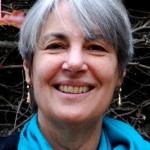Donna Newman-Bluestein leads a class using the Octaband®,
a therapy tool that she developed to encourage interaction.
Photo/submitted
By Ed Karvoski Jr., Contributing Writer
A longtime passion for dance progressed to working as a dance/movement therapist for Donna Newman-Bluestein. In recent years, personal family experience compelled her to focus her work on helping people with dementia.
“My father had dementia and I saw that the care he was given was not anywhere near good enough,” she shared. “People with disabilities who cannot speak and advocate for themselves get minimal care. I want to right that wrong.”
As a modern dance student while attending college, Newman-Bluestein was inspired by seeing performances of the Alvin Ailey American Dance Theater three consecutive nights. On the third night, she literally dreamt of pursuing a dance-related career. She shared her dream with a co-worker, who suggested she consider becoming a dance therapist.
“It clicked right away and I never looked back,” Newman-Bluestein said. “For myself, I understood that dance was about healing.”
Now, Newman-Bluestein is a board certified dance/movement therapist, mental health counselor and educator. She has worked for over 35 years with people of all ages and abilities in mental health and medical rehabilitation settings. Since 1992, she has been a senior lecturer and teaches the clinical supervision class to second-year dance therapy interns at Lesley University in Cambridge. Additionally, she provides trainings and workshops internationally.
As owner of Dance for Connection, Newman-Bluestein leads dance/movement therapy groups with older adults and people with dementia throughout eastern Massachusetts. Groups typically meet monthly.
“They may or may not remember my name, but for the most part they remember me as somebody they like to be with,” she relayed. “Their eyes brighten when they see me. They do remember people. We’re all hardwired to connect with other people – that includes babies and people with dementia. The rest of us forget it, but at those two points in life it’s really important to remember.”
Of all art forms, she feels that dance allows the greatest feeling of vitality.
“Instead of seeing what people with dementia can’t do, I see what they can do – and they’re joyous,” she explained. “There’s a humanness happening; not the feelings of suffering from isolation that they’re generally experiencing. Because dance therapists read nonverbal behavior, we’re able to understand what a person may be saying through their movement, or through their vocalizations if they can’t speak.”
Therapy is also effective for people who use canes, walkers or wheelchairs by doing seated dancing, Newman-Bluestein noted.
“Everybody moves what they can,” she said. “I try to get them to engage as much of their body as possible. By doing that, I’m encouraging them to express their feelings and ideas as much as possible.”
A common trait she has found among people with dementia is their name recognition, which prompts positive feedback.
“Regardless of what else they may or may not know, they know when their name is spoken,” she said. “Everyone is glad to hear their name over and over again. The more I do that, the more they offer and the livelier they get.”
Her dance/movement groups typically include props such as balloons, hats and streamers. While similar groups use a parachute, Newman-Bluestein instead invented a stretchy interactive device called the Octaband®.
“Through multiple sensory modes they’re getting the message, ‘I’m connected; I’m an individual and I belong to this group,’” she said.
As a performer, Newman-Bluestein is one of eight members ranging in age from 26 to 93 of the Back Pocket Dancers. Based in Cambridge, the intergenerational dance company performs throughout eastern Massachusetts.
“Every member of our group is highly valued for our unique contributions,” she said. “Every one of us is inspired by the 93-year-old. And we’re also joyous to have the 26-year-old with more energy than those of us who are older. Each of us brings our own perspective.”
Newman-Bluestein stresses that people with dementia also offer unique contributions.
“With so many more people becoming older, there’s more of an awareness of dementia,” she noted. “As the alarms about the situation have rung globally, we not only hope for a cure for people with dementia in the future, we need ways of helping them feel their gifts and not just their failings. They have many gifts.”
For more information about Donna Newman-Bluestein, visit danceforconnection.com.

Photo/submitted












